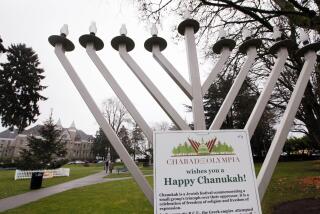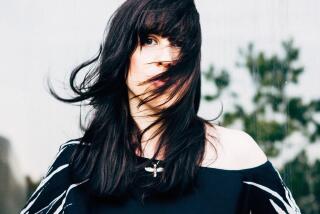Crossing the square, joining the circle
- Share via
Fifteen years ago, I spent Christmas for the first time with my husband and his family in Wisconsin.
My mother-in-law was a Berliner who had raised eight German-speaking, lederhosen- and dirndl-wearing American children. On Christmas Eve, they all gathered at their cabin in the Wisconsin woods, and as daylight faded, they strolled into the surrounding forest to cut down a pine, a gorgeous, ceiling-scraping giant with space between the branches for beeswax tapers and lead tinsel.
After tree trimming and dinner, the whole family stood in a circle, holding hands and singing carols in English and German, with a few Irish songs led by my father-in-law, a Dubliner. As a non-Christian, non-singer, I could only sway to convey the enthusiasm I was expected to feel. When my father-in-law read from the Bible, I did my best to look engaged. But through the festivities, I resisted.
I was raised to avoid organized activity of virtually every stripe. When a group forms in my midst, I step outside it.
But it was plain that first Christmas that this family defined itself by togetherness and the accumulated lore of the group. Everyone played a role, I saw, and without each person’s participation, the festivities would be off kilter.
I found the scene lovely and strange, and it made me homesick for my own, very different, family. Our main organizing principle was art -- seeing it, making it, talking and reading about it -- and there was no holiday that galvanized and united us the way literature and painting did. While I lip-synced “Good King Wenceslas,” no doubt my mother, a Londoner and a Jew, and my father, an American and a Catholic, were cozily reading novels and newspapers with their cats. Joyous displays of togetherness -- of anything -- were not their style. Nor mine.
For nearly a decade, I was an outsider in my second family, disgruntled, slightly withdrawn, occasionally disdainful. Then I had children. We skipped a few Christmases in Wisconsin, and when we did go, there were the distractions of diapers, naps and nursing. My focus shifted from my own outsider status to my children. By the time my mother-in-law died two years ago, her holiday traditions felt familiar, if still uncomfortable.
Last December, I was in Frankfurt without my family, doing research. On my way to see a retrospective of Peter Doig paintings, I found myself in a central square, the Römerberg, on the first day of the great holiday fair, the Weihnachtsmarkt.
A 30-foot Christmas tree trimmed with red and gold ornaments, garlands and bows towered above double-decker carousels. Row upon row of open-air stalls sold mulled wine in ceramic mugs, hand-carved wooden toys, nutcrackers and rocking horses, hand-knit socks, honey in seductive squat glass jars. A menacing gang of leather-jacketed young Santas lowered their cottony beards to drag on unfiltered cigarettes. A choir sang.
I was seeing those Wisconsin Christmases in context, and I could appreciate the efforts my mother-in-law made to re-create her childhood holiday for her children.
Cathedral bells rang. Luscious displays of chocolates, hard candies and marzipan were arranged in gravity-defying stacks. Vast flaps of meat sizzled over jumping flames on steel pans 10 feet in diameter.
My mouth watered and my heart ached. Alone in the Römerberg, I missed my family -- my extended, ethnically complicated family with all its cultural differences. I missed the assumed Christianity at my in-laws’ and the more-subdued holiday spirit at my parents’ house. The good and the bad in all these traditions had shaped my husband and me. It was time to embrace how they would shape my children.
My boys had recently asked me:
“Hey, Mom. We’re Jewish, right?”
“Technically” was my vague answer. I owed them more.
The Weihnachtsmarkt was not my idea of a good time: the pushy shoppers, the crèches, the cloying quaintness, but it was beautiful.
I was grateful to be able to see it by myself and in my own way. I imagined my sons riding the lavishly painted carousels, a ring of marzipan crumbs around their mouths, ecstatic.
In between the Gothic architecture of St. Bartholomeus’ Cathedral and the steel and glass of the Schirn Kunsthalle, I realized that I’d kept quiet when I should have joined the fray, spoken up, sung along, made myself heard -- in other words, been part of the group. It was time to stop resisting, avoiding, remaining aloof.
From now on, I vowed, my sons would be encouraged to choose from as wide a menu of traditions as my husband and I can offer.
This year we’ll celebrate Christmas in Los Angeles. We’re planning a feast for tonight. I don’t know what we’ll eat or who’ll be with us. My sons are certain to have ideas about how to do things, and I’m looking forward to discovering the traditions they initiate. We’ll make it up as we go along.
Samantha Peale is the author of “The American Painter Emma Dial: A Novel.”
More to Read
Sign up for The Wild
We’ll help you find the best places to hike, bike and run, as well as the perfect silent spots for meditation and yoga.
You may occasionally receive promotional content from the Los Angeles Times.






